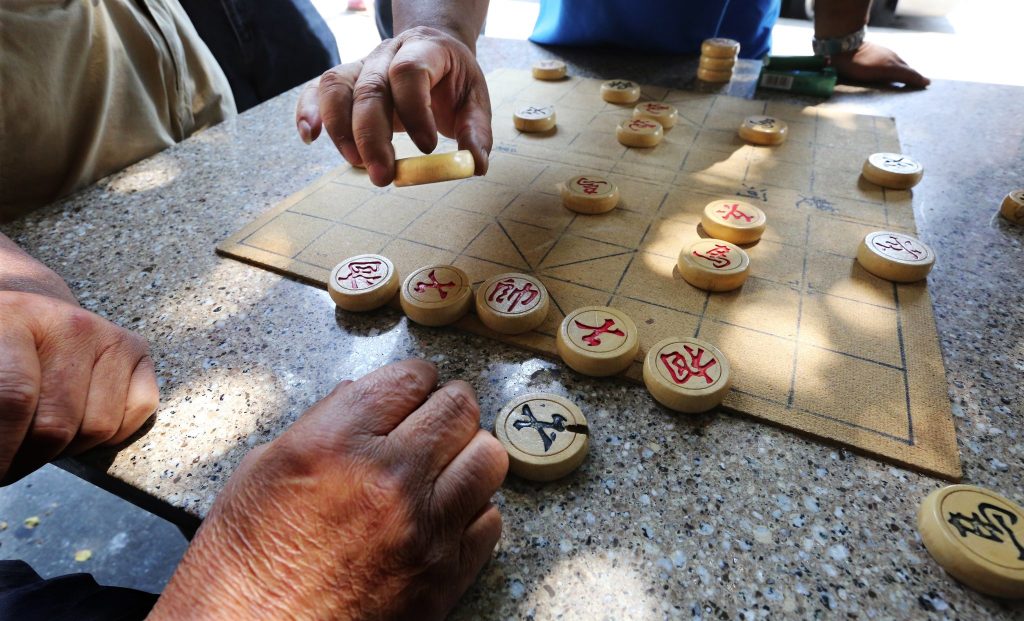
I’m trying to train for the 17th Chinese Chess World Championship, and since in chess we all know the saying: “Openings teach you openings, Endgames teach you chess” I began with very simple endgames, like King and Knight vs King and Elephant (in XiangQi the elephant is a kind of proto-bishop, like the queen today in chess is much more powerful than the same piece 800 years ago).

1. Na5-b7 Kd10-d9 2. Ke1-e2 Ba8-c10 3. Nb7-d6
4...Bc10-a8 5. Nd6-b5 (here Red is threatening a fork with Nc7) Ba8-c6 7. Nb5-c7 Kd9-d10
8. Ke2-e1 Bc6-e8 9. Nc7xe8 Now the game it's over, due to the rules of Chinese Chess, there is no stalemate, and when the enemy king or general cannot move anymore he is dead, that's why they use the ideogram for "killing" in Chinese, because someone who doesn't move is dead! However I'll put the remaining moves. 
Notice that in order to win the game one had to visualize at least 8 moves with possible other lines in the middle. These are the final moves which bring to the checkmate 9...Kd10-e10 10. Ke1-f1 Ke10-e9 11. Ne8-d6 Ke9-d9 12. Kf1-e1 Kd9-d10 13. Nd6-c8 Kd10-d9 14. Ke1-e2 Kd9-d8 15. Nc8-b10 mate!Now let’s go back to the beginning. When I read the Informant, a famous chess publication, I hated when the annotators didn’t give me an answer for some moves which could have been played in the game and seemed perfectly reasonable. Here I believe we have a similar situation, what happens if Black around move 3, continues to move the King instead of the elephant?

1. Na5-b7 Kd10-d9 2. Ke1-e2 Kd9-d10 3. Nb7-d8 Kd10-d9 4. Nd8-b9
This is the key move, because now the knight (which in Chinese is called Horse, and the ideogram of the horse is used!) controls some very important squares which through the mechanism of zugzwang can be used to give check, capture the elephant, and consequently winning the game.

4...Ba8-c6 5.Ke2-e1 (the enemy king cannot move because D8 and D10 are controlled by the Horse, and the E file is controlled by the Red king) Bc6-e8 6.Nb9-c7 (How do we call a fork in Chinese chess? A chopstick!) 
Kd9-e9 7.Nc7xe8 Ke9xe10 8.Ke1-f1 and Red wins!
At the end of this endgame, we must ask ourselves, how do we learn how to play this endgame? Is there a rule which could be applied and make our life easier (like the opposition or the rule of the square in chess endgames) or we need to calculate brute force every time? Like Socrates sometimes it’s easier to ask questions than actually answer them!
By the way, while showing this position to Jim Png (who is the greatest translator in English for Chinese chess, his dedication to helping westerners understand XiangQi translating book after book is unparalleled, and should definitely be rewarded with a Nobel prize for helping the East and the West to come in contact through something so beautiful and defying the human mind like XIangQi!) he added that Black in order to draw needs and here I quote: “go through the east door and west house formation” yes it looks like something which came out from SunZi or the I’Ching, and that’s why it’s important to study the books he has translated!
